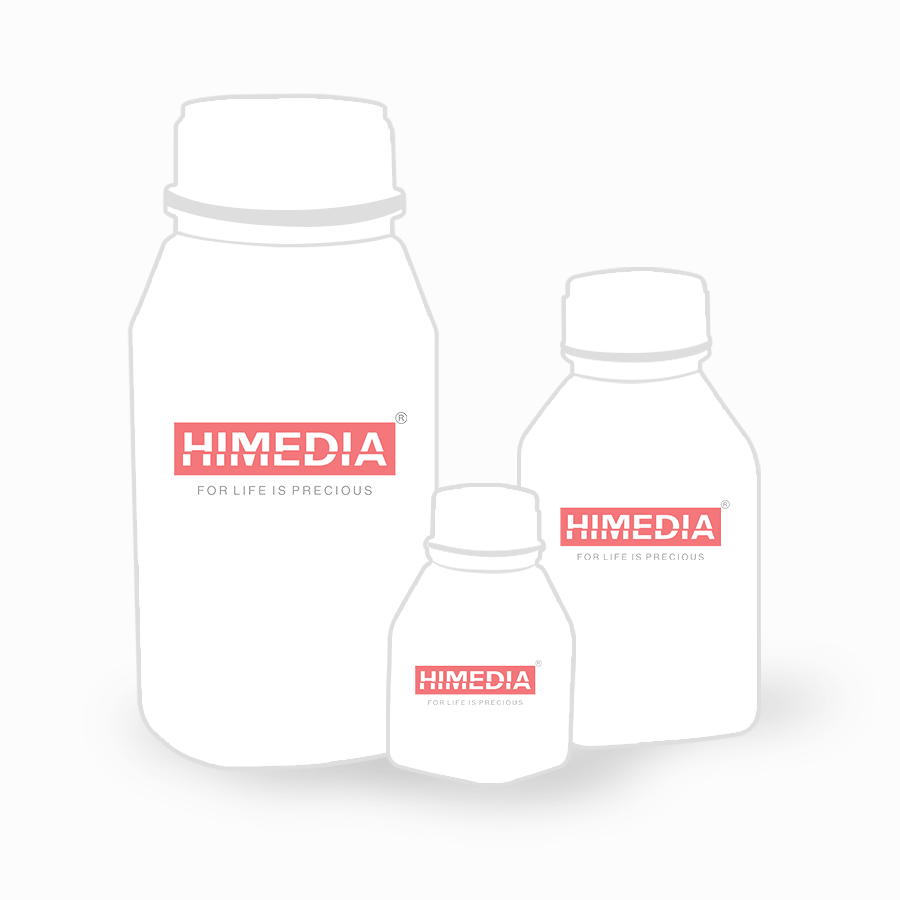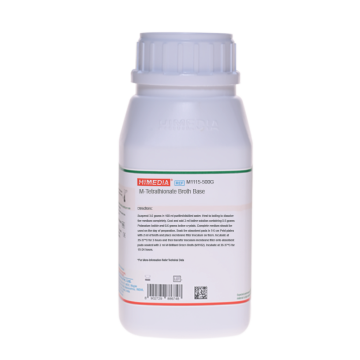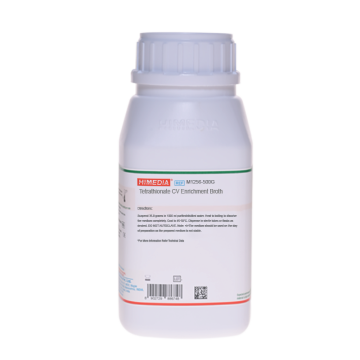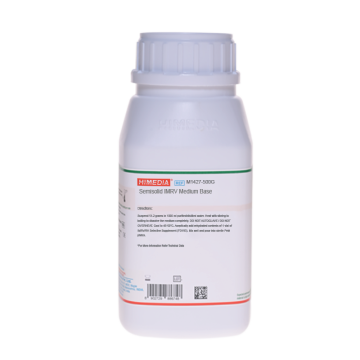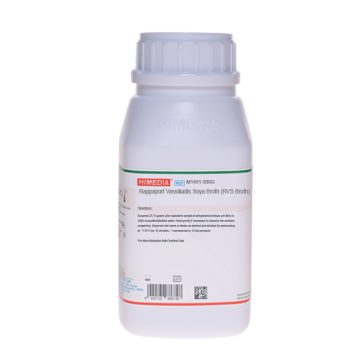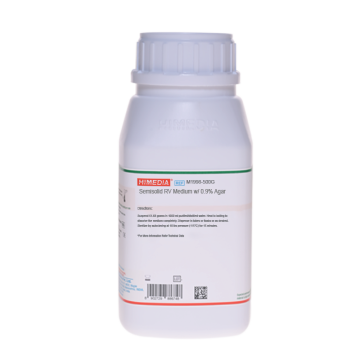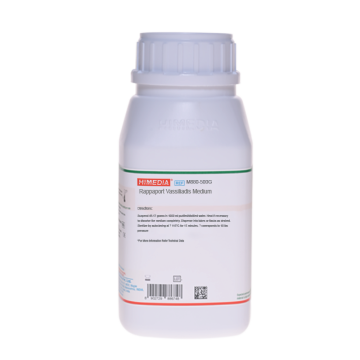 Your enquiry has been submitted
Your enquiry has been submitted
SBG Enrichment Broth (Twin Pack)
Intended Use
Recommended for selective enrichment of Salmonellae from clinical specimens.
Composition**
| Ingredients | g / L |
|---|---|
| Part A | |
| Peptone | 5.000 |
| Yeast extract | 5.000 |
| Mannitol | 5.000 |
| Sodium taurocholate | 1.000 |
| Dipotassium hydrogen phosphate | 2.650 |
| Potassium dihydrogen phosphate | 1.020 |
| Brilliant green | 0.005 |
| Part B | |
| Sodium hydrogen selenite | 4.000 |
Final pH ( at 25°C): 7.2±0.2
**Formula adjusted, standardized to suit performance parameters
Directions
Suspend 4 grams of Part B in 1000 ml purified / distilled water. Add 19.67 grams of Part A. Mix well. Heat to boiling for 5 to 10 minutes. DO NOT AUTOCLAVE OR OVERHEAT. Dispense in sterile tubes. Add 0.5 g/l sodium sulfapyridine if desired.
Caution: Sodium hydrogen selenite (Sodium biselenite) is very toxic, corrosive agent and causes teratogenicity. So it should be handled with great care. If there is contact with skin wash immediately with lot of water.
Principle And Interpretation
Salmonella are gram-negative, facultatively anaerobic, non-sporulating, motile rods in the family Enterobacteriaceae. They are widely distributed in animals affecting mainly the stomach and the intestines. These organisms are difficult to differentiate biochemically from Escherichia coli. Leifsons Selenite Medium (1) and Kauffmanns Modified Tetrathionate Medium have been widely used as enrichment medium for the isolation of Salmonella. Selenite Medium used for enrichment of Salmonella inhibits E. coli but allows growth of Proteus and Enterobacter. To overcome this difficulty, Strokes and Osborne developed a more selective medium by adding brilliant green and sodium taurocholate to the Selenite Medium and showed that it was superior to the Selenite Medium for isolating Salmonella in patients with gastroenteritis and similar diseases.
SBG (Selenite Brilliant Green) Enrichment Broth is prepared as per the formulation described by Stokes and Osborne (2) for selective enrichment of Salmonella from clinical specimens and egg products. Brilliant green and sodium selenite are neutralized by the egg constituents rendering the medium non-selective therefore sulfapyridine is added to the medium for isolation of Salmonella from eggs (3).
Peptone and yeast extract provide nitrogenous compounds, carbon, sulphur, vitamin B complex and trace elements necessary for the growth of organisms. Mannitol is the fermentable carbohydrate. Mannitol is utilized by Salmonella as an energy source, but it cannot be utilized by Proteus. Phosphates buffer the medium well. Brilliant green, sodium hydrogen selenite, sodium taurocholate inhibit the growth of gram-positive organisms and enteric organisms except Salmonella species. Whole egg and egg yolk reduces the selective properties of Selenite-Brilliant Green Enrichment. Addition of sulfapyridine restores the selective properties (3). This medium cannot be used for the isolation of Salmonella Typhi, Salmonella Paratyphi A, and Salmonella Pullorum.
Type of specimen
Clinical: faeces, rectal swabs
Specimen Collection and Handling
1 gram or 1 ml of test material is inoculated in 10 ml of the medium and incubated at 35-37°C for 18-24 hours. Following incubation, a loopful of the enriched culture is streaked on SS Agar (M108), MacConkey Agar (M081) or other plates for the isolation of Salmonella.
Warning and Precautions
In Vitro diagnostic Use. For professional use only. Read the label before opening the container. Wear protective gloves/protective clothing/eye protection/ face protection. Follow good microbiological lab practices while handling specimens and culture. Standard precautions as per established guidelines should be followed while handling clinical specimens. Safety guidelines may be referred in individual safety data sheets.
Limitations
- DO NOT AUTOCLAVE OR OVERHEAT.
- This medium is not recommended for the isolation of Salmonella Typhi, Salmonella Paratyphi A, and Salmonella Pullorum.
Performance and Evaluation
Performance of the medium is expected when used as per the direction on the label within the expiry period when stored at recommended temperature.
Quality Control
Appearance Part A : Cream to greenish yellow homogeneous free flowing powder Part B : White to cream homogeneous free flowing powder
Colour and Clarity of prepared medium Light green coloured clear to slightly opalescent solution
Reaction Reaction of 1.97% w/v of Part A + 0.4% w/v of Part B at 25°C. pH : 7.2±0.2
pH 7.00-7.40
Cultural Response Cultural characteristics observed after an incubation at 35-37°C for 18-24 hours when subcultured on MacConkey Agar (M081).
| Organism | Inoculum (CFU) | Growth (on M081) | Recovery (on M081) | Colour of colony (on M081) |
|---|---|---|---|---|
| Salmonella Choleraesuis ATCC 12011 | 50-100 | luxuriant | >=50% | colourless |
| Salmonella Typhi ATCC 6539 | 50-100 | luxuriant | >=50% | colourless |
| Salmonella Typhimurium ATCC 14028 (00031*) | 50-100 | luxuriant | >=50% | colourless |
| #Klebsiella aerogenes ATCC 13048 (00175*) | 50-100 | none-poor | <=10% | pink to colourless |
| Escherichia coli ATCC 25922 (00013*) | 50-100 | none-poor | <=10% | pink with bile precipitation |
Key:*Corresponding WDCM numbers #Formerly known as Enterobacter aerogenes
Storage and Shelf Life
Store dehydrated between 10-30°C and the prepared medium at 2-8°C. Use before expiry date on the label. On opening, product should be properly stored dry, after tightly capping the bottle in order to prevent lump formation due to the hygroscopic nature of the product. Improper storage of the product may lead to lump formation. Store in dry ventilated area protected from extremes of temperature and sources of ignition. Seal the container tightly after use. Product performance is best if used within stated expiry period.
Disposal
User must ensure safe disposal by autoclaving and/or incineration of used or unusable preparations of this product. Follow established laboratory procedures in disposing of infectious materials and material that comes into contact with clinical sample must be decontaminated and disposed of in accordance with current laboratory techniques (4,5).
Reference
- Osborne and Stokes, 1955, Appl. Microbiol., 3:295.
- Stokes and Osborne, 1955, Appl. Microbiol., 3:217.
- Leifson, 1955, Appl. Microbiol. 3:295
- Isenberg, H.D. Clinical Microbiology Procedures Handbook 2nd Edition.
- Jorgensen, J.H., Pfaller, M.A., Carroll, K.C., Funke, G., Landry, M.L., Richter, S.S and Warnock., D.W. (2015) Manual of Clinical Microbiology, 11th Edition. Vol. 1.
| Product Name | SBG Enrichment Broth (Twin Pack) |
|---|---|
| SKU | M1535 |
| Product Type | Regular |
| Physical Form | Powder |
| Origin | Animal |
| Packaging type | HDPE |
| References | 1. Leifson, 1955, Appl. Microbiol. 3:295 |
| Customized Product Available | No |



